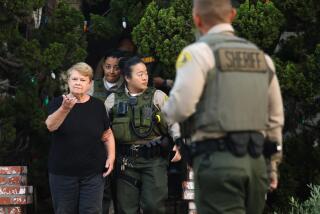Area 51: The real cover-up
- Share via
Last week, the U.S. government declassified a report about a secret facility in Nevada. Such declassifications are nothing new but, from the report’s 400 pages, two words immediately jumped out: Area 51. The government had finally acknowledged the name of a controversial base in the desert north of Las Vegas where it conducted top-secret research.
The document’s release will do little to quash the glut of Area 51 conspiracy theories about recovered alien spaceships and government cover-ups. But the real cover-up there has nothing to do with UFOs. Area 51 was more than a national security site; it was also an alleged crime scene, and at least two good men may have died from what occurred there. They were not hurt by aliens but by their own government, which refused to declassify information they needed to understand what had happened to them.
During the 1990s, I represented Area 51 workers in two lawsuits. The suits, which forced the first official recognition of the base — though not its name — were the first against a “black facility,” one whose very existence is denied by the government. Over the course of the litigation, the contents of my office were classified, I was threatened with arrest, workers and their families were threatened with prosecution and we had to go as far as Moscow to find images to prove the existence of the base.
Area 51, as the newly declassified material makes clear, was a test site for Cold War technology, including the U-2 spy plane. But it was also, according to people who worked there, a hazardous waste site, at which classified equipment and materials were disposed of in an illegal and extremely dangerous manner.
When workers at Area 51 first came to me in the 1990s, they described how the government had placed discarded equipment and hazardous waste in open trenches the length of football fields, then doused them with jet fuel and set them on fire. The highly toxic smoke blowing through the desert base was known as “London fog” by workers. Many came down with classic skin and respiratory illnesses associated with exposure to burning hazardous waste. A chief aim of the lawsuits was to discover exactly what the workers had been exposed to so they could get appropriate medical care.
The first hurdle was the government’s refusal to acknowledge even the existence, let alone the name, of the facility. We supplied pictures of the base. We supplied affidavits from workers at the base. We even submitted pictures of planes taking off in Las Vegas and then the same planes landing at Area 51. At one point, I offered to drive the judge personally to the base and point at it from a mountaintop. (The government then acquired the mountaintop and barred the public.) Ultimately, the government confirmed the existence of the base only after we located Russian satellite pictures. It turned out that the Russians had a virtual catalog of pictures of Area 51 for public sale. You just needed a credit card.
That did not end the bizarre character of the litigation. My office was off-limits to anyone but myself. I was forced to meet with my clients in seedy motels and garages to avoid their being arrested. My last memory of one client, Wally Kasza, was of him sitting in a car in a Las Vegas garage with his oxygen tank and medications. He had only weeks to live but wanted me to promise to continue to fight to hold the government accountable.
In the end, we prevailed in demonstrating that the government had acted in violation of federal law. However, the government refused to declassify information about what it had burned in the trenches, which meant that workers (and their doctors) still didn’t know what they had been exposed to. The government also refused to acknowledge the name of the base.
The burning at Area 51 was in all likelihood a federal crime. But the government escaped responsibility by hiding behind secrecy: How could the law be applied at a place that did not exist for the burning of unknown things? Of course, Kasza did exist, as did his colleagues, including another worker who died, Bob Frost. But when they became sick — with rashes, racking coughs or dreadful skin conditions — they were barred from telling doctors where they worked or what they had been exposed to. After Frost’s death, an analysis of tissue samples from his body found unidentifiable and exotic substances that one of the nation’s premier scientists could not recognize.
The newly released report doesn’t clear up those questions, and it comes after the statute of limitations has passed for any crimes that may have been committed there. The report also contradicts statements given to the court in our case. Most notably, in 1995, the government’s lead counsel, Col. Richard Sarver, told Judge Philip Pro: “Your honor, there is no name. There is no name for the operating location near Groom Lake.” Hiding behind that fiction allowed government officials to avoid accountability for these unlawful operations.
The officials responsible for those alleged crimes have now retired. But the truth is still out there. The question is whether anyone really wants to know it.
Jonathan Turley, a professor of public interest law at George Washington University, was lead counsel in the Area 51 litigation.
More to Read
A cure for the common opinion
Get thought-provoking perspectives with our weekly newsletter.
You may occasionally receive promotional content from the Los Angeles Times.










